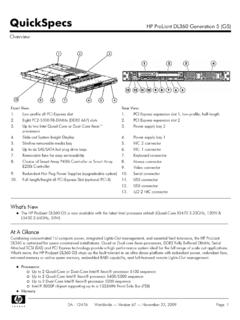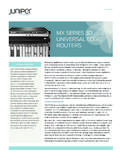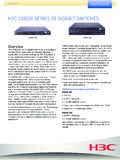Transcription of Data Center achieving enterprise San Performance …
1 Centerachieving enterprise San Performance with the Brocade DCX Backbone WHITE PAPERA best-in-class architecture enables optimum Performance , flexibility, and reliability for enterprise data Center Brocade DCX Backbone is the industry s highest-performing enterprise -class platform for Storage area networks (Sans). with its intelligent sixth-generation aSICs and new hardware and software capabilities, the Brocade DCX provides a reliable foundation for fully connected, multiprotocol San fabrics, FICOn solutions, and MetaSans capable of supporting thousands of servers and storage Brocade DCX Backbone also provides industry-leading power and cooling efficiency, helping to reduce the Total Cost of Ownership (TCO), as well as helping to reduce overall Opex.
2 This paper details the architecture advantages of the Brocade DCX Backbone and describes how It organizations can leverage the Performance capabilities, modular flexibility, and five-nines ( percent) reliability of this SAN platform to achieve specific business January 2008, Brocade introduced the Brocade DCX Backbone (see Figure 1), the first platform in the industry to provide 8 Gigabits per second (Gbps) Fibre Channel (FC) capabilities. with the release of Fabric OS (FOS) at the same time, the Brocade DCX Backbone added 8 Gbps Fibre Channel and FICON Performance for data -intensive storage January 2009, the Brocade DCX-4S (see Figure 2) was added to the backbone family, and the Brocade DCX has become a key component in thousands of data centers around the world.
3 New Fibre Channel over Ethernet (FCoE) and SAN extension blades were introduced in September 2009. In June 2010, Brocade launched the industry s first and only 8 Gbps 64-port this paper focuses on the Brocade DCX, some information is provided for the Brocade DCX-4X Backbone, notably in the section on Inter-Chassis Link (ICL) configuration. For more details on these two backbone platforms, see the Brocade DCX Backbone Family data Sheet on 3 Compared to competitive offerings, the Brocade DCX Backbone is the industry s fastest and most advanced SAN backbone, providing numerous advantages.
4 Scales non-disruptively from 16 to as many as 512 concurrently active 4 or 8 Gbps full- duplex ports in a single domain (open systems)Scales non-disruptively from 16 to as many as 256 concurrently active 4 or 8 Gbps full- duplex ports in a single domain (FICON)Enables simultaneous uncongested switching on all ports as long as simple best practices are followedCan provide Terabits per second (Tbps) (Brocade DCX) or Tbps (Brocade DCX-4S) utilizing 8 Gbps blades, Inter-Chassis Links (ICLs), and Local addition to providing the highest levels of Performance , the Brocade DCX Backbone features a modular, high-availability architecture that supports mission-critical environments.
5 Moreover, the platform s industry-leading power and cooling efficiency helps reduce ownership costs while maximizing rack density. The Brocade DCX Backbone uses just 6 watts AC per port and watts per Gbps at its maximum 8 Gbps 512-port configuration. The Brocade DCX-4S uses just watts AC per port and watts per Gbps at its maximum 8 Gbps 256-port configuration. Both are twice as efficient as its their predecessors and up to six times more efficient than competitive products. This efficiency not only reduces data Center power bills it reduces cooling requirements and minimizes or eliminates the need for data Center infrastructure upgrades, such as new Power Distribution Units (PDUs), power circuits, and larger Heating, Ventilation, and Air Conditioning (HVAC) units.
6 In addition, the highly integrated architecture uses fewer active electric components boarding the chassis, which improves key reliability metrics such as Mean Time Between Failure (MTBF).The Brocade DCX Backbone leverages a highly flexible multiprotocol architecture, supporting Fibre Channel, Fibre Connectivity (FICON), Fibre Channel over Ethernet, Fibre Channel over IP (FCIP), IP over Fibre Channel (IPFC), and data Center Bridging (DCB) IT organizations can also easily mix FC port blades with advanced functionality blades for FCoE server I/O convergence, SAN encryption, and SAN extension to build an infrastructure that optimizes functionality, price, and Performance .
7 And ease of setup enables data Center administrators to quickly maximize its Performance and availability. This paper describes the internal architecture of Brocade DCX Backbones and how best to leverage their industry-leading Performance and blade flexibility to meet business is Fibre Channel Bandwidth Measured?Fibre Channel is a lossless, low- latency, full-duplex network protocol, meaning that data can be transmitted and received simultaneously. The name of a specific Fibre Channel standard, for example 8 Gbps FC, refers to how fast an application payload can move in one direction.
8 This is called data rate. Vendors sometimes state data rates followed by the words full duplex , for example 8 Gbps full duplex , although it is not necessary when referring to Fibre Channel speeds. The term aggregate data rate is the sum of the application payloads moving in each direction (full duplex) and is equal to twice the data 1. Brocade DCX (left) and Brocade DCX-4S (right).4 BrOCade dCX aSiC FeatureSThe Brocade DCX Backbone Control Routers (CR8s) feature Brocade Condor 2 ASICs, each capable of switching at 640 Gbps. Each Brocade Condor 2 ASIC has 40 x 8 Gbps ports, which can be combined into trunk groups of multiple sizes.
9 The Brocade DCX architecture leverages the same Fibre Channel protocols as the front-end ports, enabling back-end ports to avoid latency due to protocol conversion a frame enters the ASIC, the destination address is read from the header, which enables routing decisions to be made before the entire frame has been received. This is known within the industry as Cut-Through Routing, which means that a frame can begin transmission out of the correct destination port on the ASIC even before the frame has finished entering the ingress port. Local latency on the same ASIC is s and blade-to-blade latency is s.
10 As a result, the Brocade DCX has the lowest switching latency and highest throughput of any Fibre Channel backbone platform in the Condor 2 (8 Gbps) ASICs on a port blade can act as an independent switching engine to provide Local Switching between port groups in addition to switching across the backplane. Local Switching traffic does not cross the backplane, nor consume any slot bandwidth. This enables every port on high-density blades to communicate at full 8 Gbps. That is just 700 ns at least 25 times faster than the next-fastest SAN enterprise platform on the market.









